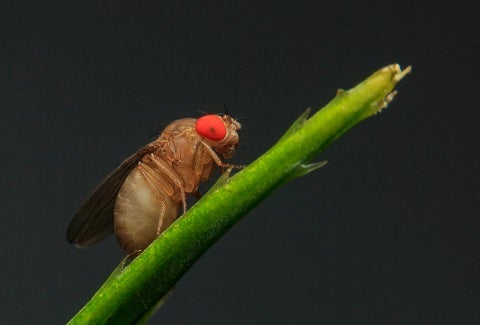By Julián Aramburu and Lina Salazar

Nothing is more annoying than a fly buzzing around your head. But flies can be much more than an annoyance: fruit flies, for example, are one of the most harmful threats to fruit production in Peru, damaging crops by laying their eggs within the fruit.
Since 1990, Peru’s fruit and vegetable exports have increased at an average annual rate of 16 percent, a growth rate faster than Peruvian merchandise exports as a whole.
However, according to the government´s National Sanitary Agricultural Authority (SENASA), at least 30 percent of the country´s total agricultural production is lost each year due to the fruit fly plague.
Some 233,000 farmers in Peru’s coastal region have had to implement pest control measures that have increased their production costs. In some cases, their access to international markets has been restricted due to phytosanitary restrictions imposed on infested areas.
The eradication of the fruit fly is therefore essential to protect the country’s fast-growing agricultural export sector and ensure the economic benefits to Peruvian farmers.
In the last two decades the Inter-American Development Bank (IDB) has been supporting the government of Peru in the implementation of phytosanitary activities including the control and eradication of the fruit fly.
In 1998, the Program for Agricultural Health (PRODESA) was the first project implemented for this purpose (a US$45 million sovereign guaranteed loan), followed by the Control and Eradication Program of the Fruit Fly (a US$15 million sovereign guaranteed loan).
In 2009, the IDB approved a third sovereign guaranteed loan for US$25 million, whose results were analyzed in the impact evaluation included in IDB’s Development Effectiveness Overview (DEO).
The efforts to eradicate the fruit fly, implemented by SENASA, included technical assistance, application of organic insecticides, releases of sterile males to reduce reproduction, and implementation of quarantine centers to monitor, detect, and restrict transportation of infested fruit from treated to untreated areas.
The program was executed in three phases from 1998 to 2014, covering more than 1 million hectares of agricultural land and 150,000 hectares of host crops —those in which the fruit fly can feed and reproduce— in the coastal area.
Did the Program Work?
In 2010, the IDB supported SENASA in designing and conducting an impact evaluation to measure the short-term effects of the third phase of the fruit fly program. The study aimed to answer two critical questions.
First, do these types of programs increase the adoption of preventative and control practices by small farmers? Second, is the program generating the impact that was initially expected as measured by insecticide use, the value of production, and sales?

Because the program was implemented in phases, borders between treated and untreated areas could be clearly identified. This in turn made the geographic regression discontinuity methodology the most suitable one for the impact evaluation, because researchers could compare farmers from treated and untreated areas that were similar along the border.
To test the effectiveness of the program, the IDB and SENASA designed a test to measure farmers’ knowledge of fruit fly characteristics as well as prevention and control measures.
The test found that farmers who participated in the program increased their knowledge about fruit flies by 10 percent and were 35 percent more likely to adopt best practices for infestation, prevention and control. The value of their fruit production and sales also increased.
However, contrary to initial expectation, farmers have been reluctant to reduce insecticide use. This might be explained by farmers’ fear of facing a fly outbreak and therefore, have not adapted their input usage in the short term.
In order to sustain the results in the long term, it’s important to understand how this type of agricultural program works in the short term. So what are the lessons from this evaluation?
The first lesson is that technical assistance and training for farmers are crucial as reflected in the difference between treatment and control of adoption of best practices to limit infestations. The farmers who increased their knowledge about pest infestations actually put into practice what they learned as a result of technical assistance provided by the program.
Farmers who received the training (the treated group) were far more likely to implement pest prevention and control measures than those who did not (the control group).
The second lesson is that training and technical assistance, combined with the other components of the program’s package, improved agricultural production considerably.
Farmers who received the full package of assistance saw a 65 percent increase in fruit production, a more than 100 percent increase in sales, and a 15 percent increase in the value of production per plant.
Overall, the impact evaluation confirms that the fruit fly program successfully achieved its main short-term objectives. Although more studies will be needed to verify whether this program is a long-term solution, it clearly is a good start.
This story is one of the impact evaluations included in the Development Effectiveness Overview, an annual publication that highlights the lessons learned from IDB projects and evaluations.
Download here the evaluation “Estimating the Impacts of a Fruit Fly Eradication Program in Peru: A Geographical Regression Discontinuity Approach“.
About the authors:
Julián Aramburu is currently a Ph.D student in Economics at Yale University. Prior to joining Yale, he worked as an impact evaluation consultant in the Environment, Rural Development and Disaster Risk Management Division in the IDB headquarters in Washington, DC.
Lina Salazar is an economics senior specialist in the Environment, Rural Development and Disaster Risk Management Division in the IDB headquarters in Washington, DC.


Leave a Reply